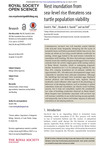Please use this identifier to cite or link to this item:
http://lib.hpu.edu.vn/handle/123456789/23637Full metadata record
| DC Field | Value | Language |
|---|---|---|
| dc.contributor.author | Pike, David A. | en_US |
| dc.contributor.author | Roznik, Elizabeth A. | en_US |
| dc.contributor.author | Bell, Ian | en_US |
| dc.date.accessioned | 2016-10-11T05:37:40Z | |
| dc.date.available | 2016-10-11T05:37:40Z | |
| dc.date.issued | 2015 | en_US |
| dc.identifier.other | HPU4160559 | en_US |
| dc.identifier.uri | https://lib.hpu.edu.vn/handle/123456789/23637 | en_US |
| dc.description.abstract | Contemporary sea-level rise will inundate coastal habitats with seawater more frequently, disrupting the life cycles of terrestrial fauna well before permanent habitat loss occurs. Sea turtles are reliant on low-lying coastal habitats worldwide for nesting, where eggs buried in the sand remain vulnerable to inundation until hatching. | en_US |
| dc.format.extent | 5 p. | en_US |
| dc.format.mimetype | application/pdf | en_US |
| dc.language.iso | en | en_US |
| dc.subject | Biology | en_US |
| dc.subject | Ecology | en_US |
| dc.subject | Cheloniamydas | en_US |
| dc.subject | Immersion | en_US |
| dc.subject | Nesting habitat | en_US |
| dc.title | Nest inundation from sea-level rise threatens sea turtle population viability | en_US |
| dc.type | Article | en_US |
| dc.size | 361KB | en_US |
| dc.department | Education | en_US |
| Appears in Collections: | Education | |
Files in This Item:
| File | Description | Size | Format | |
|---|---|---|---|---|
| 0442_Nestinundation.pdf Restricted Access | 361.41 kB | Adobe PDF |  View/Open Request a copy |
Items in DSpace are protected by copyright, with all rights reserved, unless otherwise indicated.
